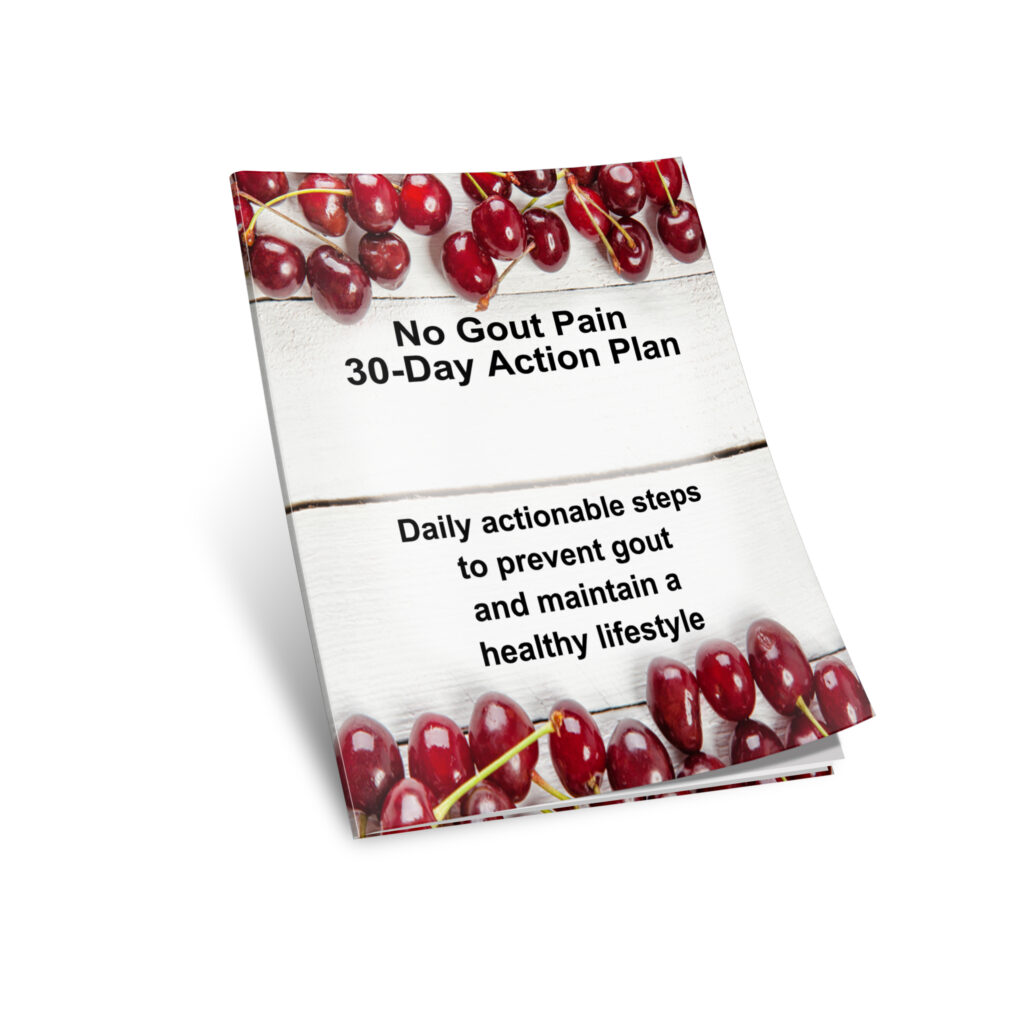This 30-day gout action plan is designed to help you do just that, by providing daily actionable steps to prevent gout and maintain a healthy lifestyle.

Download your free PDF copy of this 30-day checklist – Click Here – The 30-day checklist is same information in this article. The checklist makes it simple to keep track of your progress.
Day 1: Hydrate and eliminate sugary drinks. Aim to drink at least 8 glasses of water a day. Instead of sugary drinks, try unsweetened herbal tea or infused water. Consider adding some cherry juice concentrate to a daily glass of water to reduce uric acid and gout pain naturally.
Day 2: Increase intake of low-fat dairy products. Examples include skim milk, low-fat yogurt, and cheese. Try incorporating these into your meals or snacks.
Day 3: Limit intake of purine-rich foods. These include red meat, organ meats, shellfish, and some vegetables such as asparagus and spinach. Replace these with low-purine options such as chicken, tofu, and vegetables like broccoli and kale.
Day 4: Add more plant-based protein sources to your diet. Examples include lentils, beans, and quinoa. Try a vegetarian meal for the day.
Day 5: Practice stress-reducing activities. Examples include yoga, meditation, or deep breathing exercises. Choose a practice that works for you and spend at least 10 minutes on it.
Day 6: Get moving with moderate exercise. This can include activities like brisk walking, cycling, or swimming. Aim for at least 30 minutes of activity today.
Day 7: Eliminate alcohol for the day. If you regularly drink alcohol, take a day off to give your body a break.
Day 8: Increase intake of vitamin C-rich foods. Examples include citrus fruits, strawberries, and bell peppers. Incorporate at least one of these into each meal.
Day 9: Try a low-purine breakfast. Examples include oatmeal with almond milk and berries, or scrambled eggs with spinach and mushrooms.
Day 10: Get a good night’s sleep. Aim for 7-8 hours of sleep tonight.
Day 11: Incorporate cherries or cherry juice into your diet. Try a cherry smoothie or add dried cherries to your oatmeal or yogurt.
Day 12: Practice gratitude. Spend at least 5 minutes today reflecting on things you are grateful for.
Day 13: Go for a walk after dinner. This can help with digestion and increase physical activity.
Day 14: Limit intake of processed and packaged foods. These can often contain high amounts of salt and sugar. Opt for whole foods instead.
Day 15: Swap out sugary snacks for fresh fruit. Try a piece of fruit with almond butter or a fruit salad.
Day 16: Increase intake of omega-3 fatty acids. Examples include fatty fish like salmon, chia seeds, and walnuts. Incorporate at least one of these into your meals today.
Day 17: Eliminate fast food for the day. Try cooking a healthy meal at home instead.
Day 18: Take a hot bath with Epsom salt. Epsom salt can help with relaxation and reducing inflammation.
Day 19: Do a gentle yoga practice before bed. This can help with relaxation and improve sleep.
Day 20: Incorporate turmeric into your meals. This spice has anti-inflammatory properties. Try adding it to a curry or roasted vegetables.
Day 21: Try a new low-purine recipe. Look up a recipe online and give it a try.
Day 22: Increase intake of fiber-rich foods. Examples include fruits, vegetables, whole grains, and legumes. Try incorporating these into your meals or snacks.
Day 23: Practice mindfulness. Spend at least 5 minutes today focusing on the present moment.
Day 24: Limit intake of high-fructose corn syrup. This is commonly found in sugary drinks and processed foods. Opt for natural sweeteners instead.
Day 25: Eliminate caffeine for the day. Try herbal tea instead.
Day 26: Go for a hike or nature walk. Spending time in nature
Day 27: Try meditation or deep breathing exercises to reduce stress and inflammation levels in the body. For example, set aside 10 minutes in the morning and evening to sit quietly and focus on your breath. Alternatively, you could try a guided meditation app or join a local meditation group.
Day 28: Incorporate low-impact exercise into your daily routine, such as swimming, cycling, or yoga. These types of exercise can help improve joint mobility and reduce inflammation. Try going for a 30-minute walk or taking a yoga class.
Day 29: Practice good sleep hygiene by establishing a consistent bedtime routine and creating a calming sleep environment. Make sure your bedroom is cool, dark, and quiet, and avoid electronic devices for at least 30 minutes before bed.
Day 30: Reflect on your progress over the past 30 days and set new goals for maintaining a gout-free lifestyle. Consider continuing some of the daily habits you have established, such as drinking plenty of water, eating a healthy diet, and getting regular exercise. Celebrate your success and continue to prioritize your health and well-being.
Click here to learn more about the No Gout Pain Cookbook available on Amazon.
Visit Traverse Bay Farms to learn more about gout, cherry juice and tart cherry capsules.
We do not provide any sort of medical advice. Please consult your doctor or medical health professional prior to taking any type of dietary supplement.


























